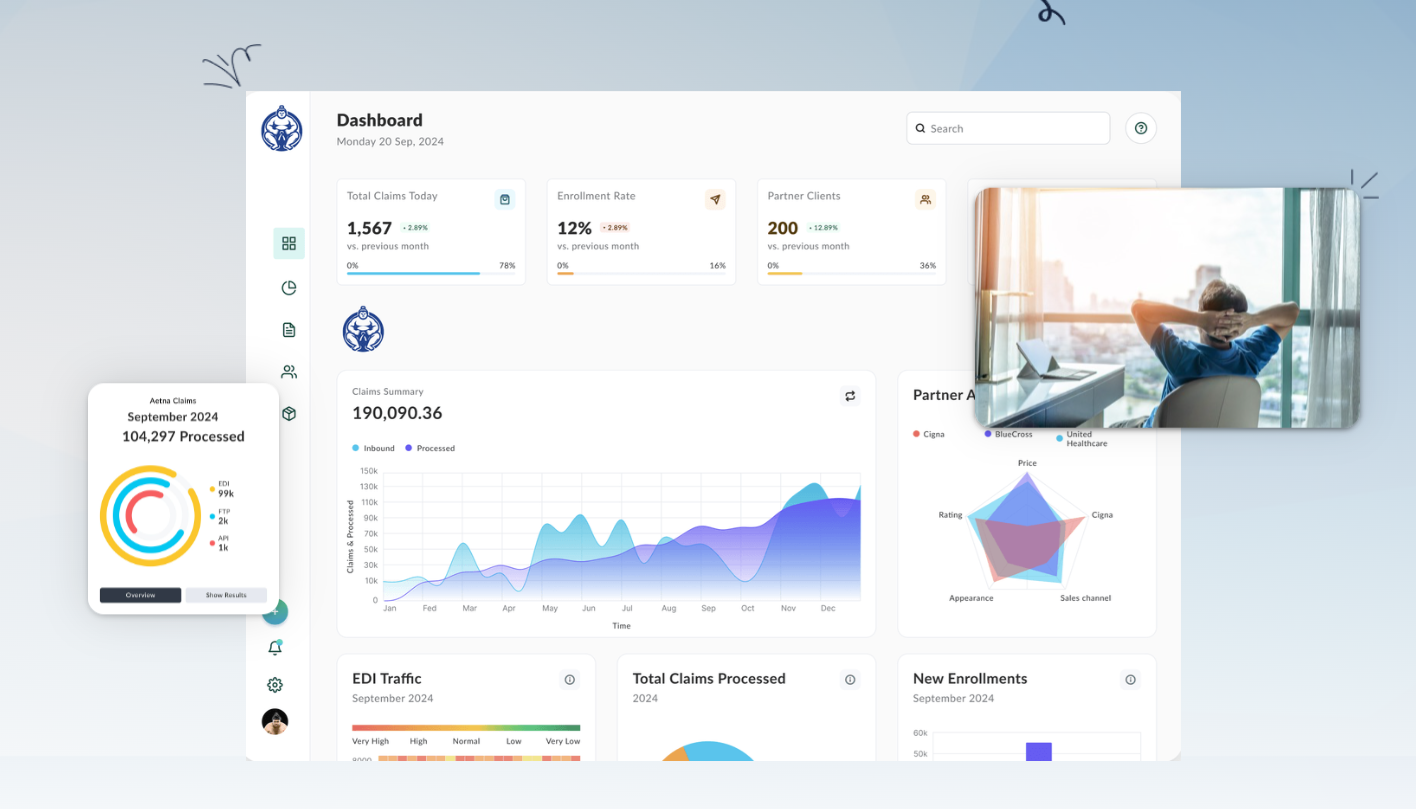Evaluating Cloud vs. On-Premise EDI Solutions for Health Insurance Data Integration


Choosing between cloud-based and on-premise EDI solutions is one of the most critical technology decisions for healthcare insurance organizations integrating complex enrollment, eligibility, and claims data. At EDI Sumo, we work with health, dental, and vision payers—many of whom are grappling with this exact question as they strive to streamline operations, ensure compliance, and reduce IT overhead. Rather than offering generics, we want to dive deep—grounded in our real-world expertise—to help leaders like CIOs, IT Directors, EDI Coordinators, and Enrollment/Claims Directors make truly informed decisions.
Why EDI Deployment Models Matter in Healthcare Insurance
Health insurers face specific EDI integration challenges: multi-format data (from 834s, 837s, custom CSV/XML, etc.), strict HIPAA and audit requirements, massive data volumes, and the unrelenting demand for responsiveness from providers, members, and regulators. Selecting the right EDI architecture directly impacts your ability to:
- Comply with HIPAA and avoid data breaches
- Meet service level agreements (SLAs) and avoid penalties
- Empower business users with timely data
- Scale without overburdening IT teams
- Integrate seamlessly with claims and enrollment systems
Pros and Cons: On-Premise vs. Cloud EDI in Health Insurance Integration
On-Premise EDI Solutions
- Security & Control: Direct, local control over sensitive PHI and EDI files. Some organizations with strict internal data policies find this model more comfortable.
- Customization: Heavily customizable to unique flows, non-standard formats, and highly specialized validation rules.
- Compliance: Supports installation of advanced security protocols and enterprise-grade access controls tailored to your audited standards.
- Predictable Costs: Capital expenditure upfront. No recurring licensing, but ongoing internal IT costs.
- Potential Drawbacks:
- Upgrades, scaling, maintenance (MFA, OAuth2, security patches), and integrations all fall to your IT team.
- Risk of technology obsolescence and being locked into legacy platforms.
- Higher barrier to provide real-time analytics and agile response—especially for distributed or hybrid workforces.

Cloud-Based EDI Solutions
- Scalability: Effortlessly handles millions of transaction records with modular, elastic infrastructure.
- Reduced IT Burden: Puts day-to-day EDI management, monitoring, and error resolution in the hands of business users, freeing IT for strategic projects.
- Disaster Recovery & High Availability: Built-in redundancy, failover, and round-the-clock monitoring.
- Real-Time Collaboration: Enables geographically dispersed teams to securely access, review, and collaborate on files and eligibility/claim records instantly.
- Rapid Integration: Easily connects to claims management, enrollment, and CRM systems through standard APIs or native adapters.
- Compliance Advantage: Modern cloud EDI platforms often come with pre-baked HIPAA, SOC2, and GDPR controls, with a real-time audit trail for every interaction.
- Potential Drawbacks:
- May require closer scrutiny of vendor security (data residency, encryption standards).
- Depending on architecture, some fine-grained customizations could be more restricted compared to on-premise deployments.
- Ongoing operating expense (OpEx) model, which may require budget realignment.
Key Evaluation Criteria for Health Insurance Organizations
- HIPAA and Audit Readiness: Can the solution automate compliance tracking, audit trails, and role-based access for all EDI file activity?
- Multi-Format and Integration Support: Does it natively handle diverse EDI, CSV, XML, and proprietary formats? Is it compatible with your claims management and EDI translator systems?
- Real-Time Monitoring and SLA Management: How easily can you track eligibility and claims status, receive automated alerts, and quickly resolve discrepancies?
- IT Resource Allocation: Is your IT team equipped for deep ownership, or would business-led EDI management reduce bottlenecks?
- Cost Model and ROI Timeline: Do you prefer capital expenditure with slower ROI (on-premise), or pay-as-you-go with rapid time-to-value (cloud)?
- Security Posture: Does the platform employ modern encryption (in transit and at rest), support advanced authentication, and ensure your PHI never leaves your control?
Where EDI Sumo Fits: A Flexible Approach to Meet Your Context
What we've found at EDI Sumo is that health insurers rarely fall neatly into one category. Some want the full control of on-premise, others crave the speed and lower IT overhead of cloud, and many seek a hybrid approach. Our platform is designed to integrate with existing claims systems, support real-time monitoring, and automate compliance tracking—regardless of whether we deploy in the cloud or on your own infrastructure. Here’s a quick look at how our approach tackles the real-world concerns of health insurers:
- Real-Time Monitoring: Instantly track all enrollment, claim, and eligibility file movements, with automated SLA and error alerts (see more).
- Multi-Format Support: Native handling of EDI 834/837s, CSV/Excel, XML, and positional files—eliminating the need for custom scripting or third-party tools (learn more).
- Seamless Integration: Connects to leading claims and payer systems (including Guidewire, Healthspring, Cigna, Aetna, and more) without manual file juggling (integration partners).
- Security and Compliance: Available with strong encryption, audit trails, and installed on-premise where stricter compliance is required (security overview).
When Should You Choose On-Premise vs. Cloud?
Looking across our client base, the choice comes down to:
- On-Premise if:
- You have highly sensitive data that must remain in-house for compliance, legal, or organizational reasons
- You require deep customization or have highly specialized, legacy integration needs not easily replicated in the cloud
- Your IT team already excels at managing secure, always-on critical systems
- Cloud if:
- You need to quickly modernize without a massive hardware/infrastructure outlay
- You want business users—like customer support or enrollment teams—to have secure, instant access without IT bottlenecks
- You anticipate volume spikes or need easy scalability (open enrollment, regulatory deadlines, etc.)
- You prioritize faster updates and access to the latest features and compliance tools
Best Practices: Making the Transition Smoothly
No matter which path you pursue, a few lessons from our implementation experience can save you headaches down the road:
- Start with a Gap Analysis: Map your current data flows, bottlenecks, and compliance gaps before comparing deployment models.
- Prioritize Stakeholder Access: Involve end users early—claims, enrollment, customer service, compliance—not just IT.
- Insist on Auditability: Whether cloud or on-prem, real-time audit trails dramatically simplify compliance and protect against data lapses.
- Test High-Volume and Edge Cases: Particularly in healthcare, validating across busy enrollment/claims peaks and unusual file formats is crucial.
- Think Future-Proof: Consider not just today’s needs, but how easy it will be to incorporate new trading partners or meet new regulatory demands in the next 3-5 years.
The EDI Deployment Model is Strategic, Not Just Technical
The debate between cloud and on-premise EDI is more than a purely technical choice—it’s a strategic decision that shapes your organization’s agility, risk profile, compliance standing, and ultimate capacity to deliver value to members and providers. At EDI Sumo, we believe the ideal solution is the one that most closely fits your unique context—and provides flexibility as your needs evolve.
If you’re evaluating your next step in EDI modernization or have pressing compliance and SLAs to meet, we’d love to share lessons from the field or discuss how others have navigated this transition. Learn more about our flexible, secure, and streamlined EDI management approach at edisumo.com—or schedule a practical demo tailored to your data integration environment.


.png)





.png)

.png)


.png)
